

A B C D E F G H I J K L M N O P Q R S T U V W X Y Z
|
Page 1: Lab Escape - Lawn Tennis Page 2: Lazer Tag - Licence to Kill Page 3: Life Expectancy Zero - The Living Daylights |
Page 4: Livingstone - Lotus Esprit Turbo Challenge Page 5: Lucky Fruits - The Lurking Horror |
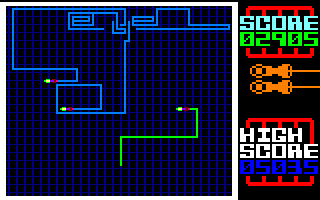 |
Life Expectancy Zero
(Blaby, 1985) Tron has always been a classic game, but this is an uninspiring version of it. You have to play against the computer light cycles and try to trap them and cause them to crash into their own trails. The first level contains only one light cycle, with another being added until there are five; after that, you play the five levels again, but at a slightly faster pace. The graphics are good when you consider other versions of this game, but it's much too easy, since the computer-controlled light cycles are quite stupid and will trap themselves without you having to do it for them. 4 |
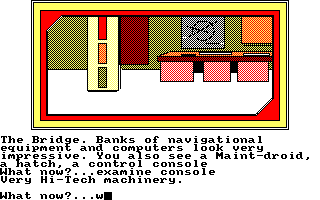 |
Lifeterm
(Alternative, 1987) In the year 3147, Jake Stalin was sent to the planetoid of Souzel to serve a life sentence for murder, and he now wants to escape... but how is he going to do it? This is a text adventure created using GAC, and let's just say that it's not very good at all. The locations are laid out in a very illogical manner and it's easy to get lost, and the first few commands that you need to type to make any progress are really obscure (the answers are to send an SOS, lock the pilot in the store, and send the droid to the ship – so now you know). The graphics are OK but it's very hard to know what you should do. 4 |
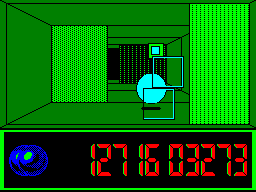 |
The Light Corridor
(Infogrames, 1990) Breakout gets a twist here as you bounce a ball down a never-ending corridor full of barriers and obstacles. Along the way, there are several types of power-ups to collect, and every four levels, there's a task to be solved, such as aiming the ball at a target, or hitting it several times; only when you complete it within the time limit can you progress to the next set of corridors. The graphics are impressive, and if you have 128K of memory, there are several excellent tunes, and you even get some digitised speech. In addition, there's the facility to design your own corridors, and a code for each corridor means that you won't have to play the ones you've completed over again. One other thing – select 'fast control' from the options menu; the game is much easier if you use this. 8 |
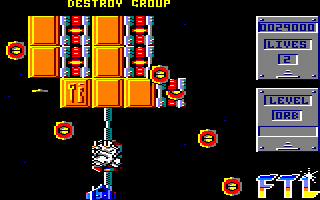 |
The planet of Regulus is under attack by alien forces, so the GEM council sends out their entire army, which consists of exactly one Lightforce fighter, to destroy the aliens. Guess who the pilot of this fighter is? This is a vertically scrolling space shoot-'em-up which is full of action from start to finish. There is a wide variety of aliens which approach in waves, and thankfully it's easy to learn their formations and the best way to defeat them. Control centres also appear every so often, and shooting them all gives you extra lives at the end of each of the four levels. The graphics and sound effects are both excellent, and it's a challenging game, whether you're a novice or a hardened shoot-'em-up fan. 8 |
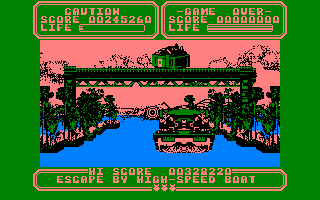 |
Line of Fire
(US Gold, 1990) You've infiltrated enemy lines and captured their secret, high-power machine gun unit – but now you're going to need to use the weapon to fight your way out, as you enter the line of fire. The game uses a perspective view, and enemy soldiers and vehicles come towards you. You must simply shoot them, or use smart bombs to kill everything on the screen, although you only have two of these available at the start of the game. However, more can be collected by shooting caskets, and shooting first aid kits allows you to recover some of your energy. The graphics are poor and very messy, and the scrolling is slow and jerky. The few sound effects that exist are also bad (although the music on the menu is good), and all of this makes the game dull and unexciting. 5 |
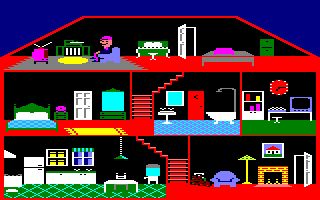 |
Little Computer People
(Activision, 1987) There are bizarre games, and then there's this one – but can you call it a game at all? When you first run the game, you are assigned your own Little Computer Person (it's always male), and you watch him and his dog move into his house and settle in. Then, in subsequent sessions, you just leave the computer switched on as he goes about life, doing exercises, watching TV, playing the piano, using the telephone (who does he talk to?), and so on. You'll also have to watch his food and water supply, and you can also type in commands to get him to play games or write a letter to you. It is fun to watch him at first, but the novelty will wear off sooner or later. 7 |
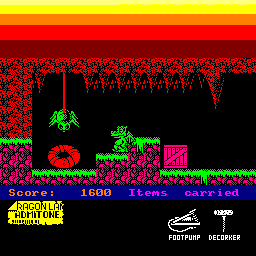 |
Little Puff in Dragonland
(Codemasters, 1989) Little Puff went to explore Dragonland, but he has become lost and wants to go home. However, two guards won't let him home unless he finds four pieces of a pass and pays a toll. This is an arcade adventure which is similar to the Dizzy series – but it's not as good. Working out what objects are needed isn't difficult, although there are several objects which have no use. The ugly, Spectrum-like graphics are a bit off-putting, despite some clever techniques being used to display extra colours on the screen. The main reason why the game isn't that good, however, is that you only have one life, and it is so easy for Puff to be killed – a mistimed jump, or a fall into one of the many traps. It would be much better if you were given three lives. See also: DJ Puff. 6 |
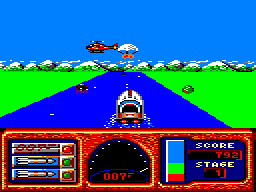 |
Live and Let Die
(Domark/Elite, 1988) A drugs baron called Dr. Kananga has killed three British agents, and it's up to James Bond to find him and destroy his drug processing plant. The only real link to the film in this game is the use of a speedboat. You can choose one of three missions in the Arctic, the Sahara or New Orleans, although it might be best to start with the practice level in which you fire at targets. Each of the missions sees you piloting the speedboat along a river, firing at enemy speedboats and 'planes, and dodging rocks and mines. You also need to collect fuel canisters regularly. The graphics are good and the scrolling is fast and smooth, but for some reason, the gameplay seems to be fairly average and lacks something. See also: Licence to Kill, The Living Daylights, The Spy Who Loved Me, A View to a Kill. 6 |
 |
Liverpool
(Grandslam, 1990) Liverpool FC is one of the most famous football clubs in England, so it would seem appropriate to licence their name for a computer game. Sadly, the result is nothing short of an insult to the club's name. Obviously, you always play as Liverpool, and can play a friendly with another team, or participate in a league with several other teams. The graphics are poor and very blocky, and the animation of the players is awful; the goalkeeper can only move up and down, and as you're traversing the pitch, most of the other players seem to be frozen. Aiming the ball and scoring goals is very difficult as well, but the worst aspect of the game is that it is really slow. It's likely that you'll switch off and play something else before the match reaches full time. 2 |
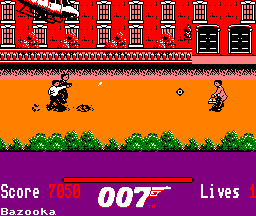 |
James Bond is hunting Brad Whittaker, an arms dealer who is supplying the Russian defector General Georgi Koskov. The game involves running and shooting your way through eight levels. As James Bond, you travel around the world in pursuit of Whittaker, starting in Gibraltar and then going to Russia, the United Kingdom, Morocco and Afghanistan. Before each level (except the first and last ones), you must choose another weapon to use, and during the game, you can change your weapon by pointing your crosshairs at the bottom of the screen. The graphics are very good indeed, with some nice trickery used to provide extra colours, and the music and sound are also excellent. However, the levels are all very similar, and some of them are very short as well. See also: Licence to Kill, Live and Let Die, The Spy Who Loved Me, A View to a Kill. 6 |